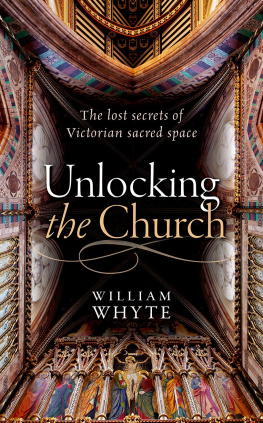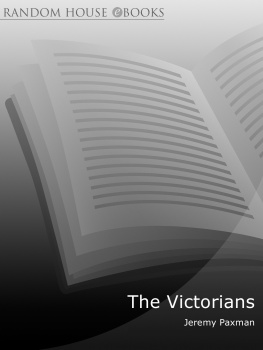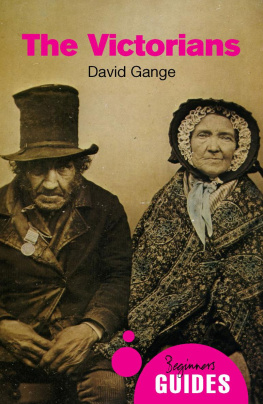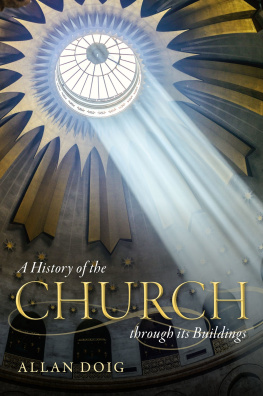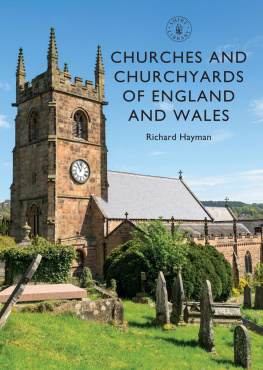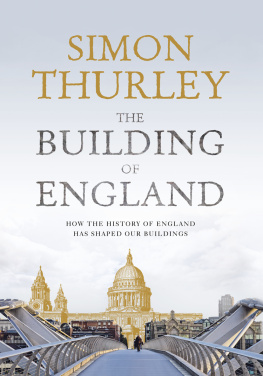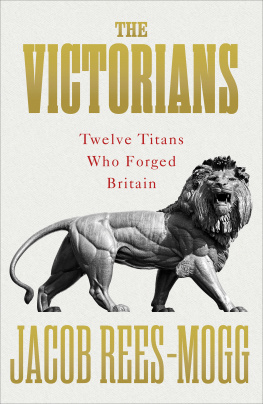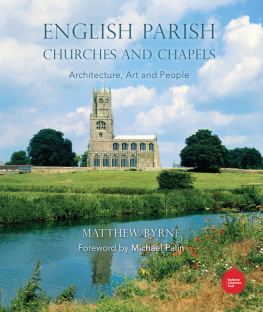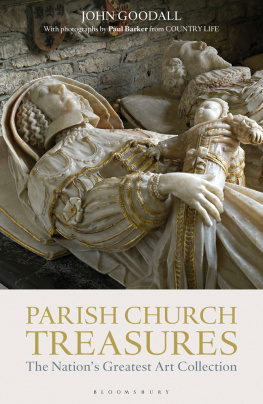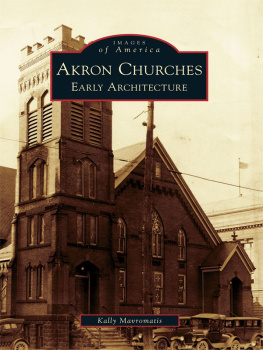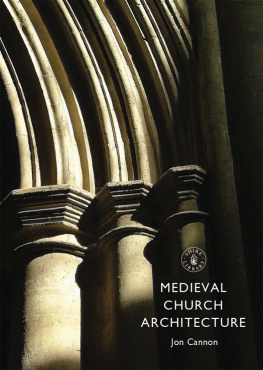Unlocking the Church

Great Clarendon Street, Oxford, ox 2 6 dp , United Kingdom
Oxford University Press is a department of the University of Oxford. It furthers the Universitys objective of excellence in research, scholarship, and education by publishing worldwide. Oxford is a registered trade mark of Oxford University Press in the UK and in certain other countries
William Whyte 2017
The moral rights of the author have been asserted
First Edition published in 2017
Impression: 1
All rights reserved. No part of this publication may be reproduced, stored in a retrieval system, or transmitted, in any form or by any means, without the prior permission in writing of Oxford University Press, or as expressly permitted by law, by licence or under terms agreed with the appropriate reprographics rights organization. Enquiries concerning reproduction outside the scope of the above should be sent to the Rights Department, Oxford University Press, at the address above
You must not circulate this work in any other form and you must impose this same condition on any acquirer
Published in the United States of America by Oxford University Press 198 Madison Avenue, New York, NY 10016, United States of America
British Library Cataloguing in Publication Data
Data available
Library of Congress Control Number: 2017932100
ISBN 9780198796152
ebook ISBN 9780192515933
Printed in Great Britain by Clays Ltd, St Ives plc
Links to third party websites are provided by Oxford in good faith and for information only. Oxford disclaims any responsibility for the materials contained in any third party website referenced in this work.
For E. J. G. and J. M. C
With heartfelt thanks
Preface
All Victorian collections of sermonsand I have read hundreds, if not thousands of Victorian sermons in the writing of this bookbegin with a conventional apology, with the author declaring I had no intention of publishing what follows. Sometimes this was probably true; quite often one closes the volume assuming that it really can only have been in response to the entreaties of well-meaning friends that the authors unremarkable reflections found themselves in print. But when a writer like F. W. Farrar, who is listed as the author of no fewer than 298 publications in the British Library catalogue, observes at the opening of his collection of sermons that in allowing them to appear in this form I yield to considerable pressure, the reader might be forgiven for wondering what pressure he was actually under.
The pressure to publish for a modern academic is a very real one. And its not just kindly friends who urge you on. It would be simply dishonest to pretend that I was inveigled into producing what follows. But, just like my Victorian forbears, I do owe a real debt to those who have encouraged me. At the heart of this book is a revised version of the Hensley Henson Lectures which I gave in the closing months of 2014. I am enormously grateful to the Henson electors for inviting me to give them, and thankful to those who attended the series.
Many of these ideas have also been tried out in response to other invitations. I must thank Robin Griffith-Jones and David Park for asking me to speak at their conference on the Temple Church at the Courtauld Institute in 2008; Peter Jan Margry and Jan de Maeyer for inviting me to participate in their workshop on Material Reform at the University of Leuven in 2012; Alex Bremner and Jonathan Conlin for asking me to speak at their conference on E. A. Freeman at St Deniols Library in 2012; Peter Scott for inviting me to lecture at his conference at the Lincoln Theological Institute in Manchester in 2013; Matthew Walker for inviting me to present a paper at his symposium on the afterlife of Wren in 2014; Jill Campbell, Mark Gardiner, and Liz Thomas for asking me to give the opening address at their Buildings in Society International conference in Belfast in 2014; and Edward Gillin and Horatio Joyce for doing the same at their conference on Architecture and Experience in the Nineteenth Century, held in Oxford in 2016. I am grateful, too, to the Oxfordshire Historic Churches Trust, who asked me to give their Blenheim lecture in 2014 and the Berkshire Historic Churches Trust, for whom I gave the Englefield Lecture in 2016. Just as I was putting the finishing touches to the text, Stephen Wildman invited me to give the Mikimoko Memorial Ruskin Lecture at Lancaster and I most sincerely thank him for such a marvellous opportunity to explore these ideas still further.
Along the way, I have also given papers on these subjects at seminars in Cambridge, Edinburgh, Lewes, London, Oxford, and elsewhere. I have had the opportunity to try out some early thoughts in a number of books, including Joe Sterrett and Peter Thomas, eds, Sacred TextSacred Space: architectural, literary, and spiritual convergences in England and Wales (2011) and two forthcoming volumes: the Oxford Handbook of Nineteenth-Century Christian Thought and the Oxford Handbook of Victorian Medievalism. I am grateful to George Clarke and the team from Channel 4s Restoration Man who have taken me with them to explore churches and chapels from Plockton to Little Braxted. I must likewise thank Rachel Boulding and Sally Fraser for letting me try out some of this in the pages of the Church Times. The real starting point for all this work was my involvement in Redefining Christian Britain: post-1945 perspectives (2007), and I should like to express my gratitude to my co-editors and contributors for that wonderful experience.
In addition to all the many people who have commented on this work at lectures, seminars, workshops, and in print, I should like to thank the anonymous readers whose wise advice and stern counsel proved immeasurably helpful. I am also grateful to two historians of very different periods and somewhat different interestsGeorge Bernard and Otto Saumarez Smithwho read the whole of my draft and offered telling advice. My editor Matthew Cotton was enormously encouraging from the first and helped me transform the text from my initial lectures. Luciana OFlaherty then very kindly took me on. I am terrifically grateful to Gayathri Manoharan, Dawn Preston, Kizzy Taylor-Richlieu and Donald Watt, who have miraculously turned my text into a book, and I must also express my thanks to those who shared their work with me, especially Philip Aspin, James Bettley, Simon Bradley, Kate Giles, Edward Gillin, Matthew McDade, Otto Saumarez Smith, Ruth Slatter, Geoffrey Tyack, and Martin Wellings. All errors, of course, remain entirely my own. For permission to reproduce images, I thank the Bodleian Library, Jane Garnett, the Historic England Archive, Historic Environment Scotland, the Dean and Chapter of Lichfield Cathedral, the Manchester Climbing Centre, the North Devon Athenaeum, and John Whitworth. John Betjemans A Lincolnshire Church is reproduced with permission from John Murray Press.
This project could not have been undertaken, much less completed, without the support of the Oxford History Faculty and of St Johns College, who very generously granted me a years research leave. Together with the Faculty of Theology and Religion, St Johns also underwrote the cost of image reproduction and I am deeply sensible of this generosity. I am grateful to successive Theology ChairsSarah Foot and Johannes Zachhuberfor all their support before, during, and after the Henson Lectures, and am especially thankful to my historical colleagues at collegeAntonia Fitzpatrick, Dan Hicks (an honorary historian for the occasion), Kit Kowol, Elizabeth Macfarlane, Hannah Skoda, Alan Strathern, and Mark Whittow. Joshua Bennett was particularly heroic in taking on my teaching. The library staff at St Johns, Worcester College, and the Bodleian were immeasurably helpful throughout. And I am most grateful to the parishioners of Kidlington with Hampton Poyle who have put up with much of this in sermon form over the last ten years (without, it should be said, ever insisting I publish any of it).

